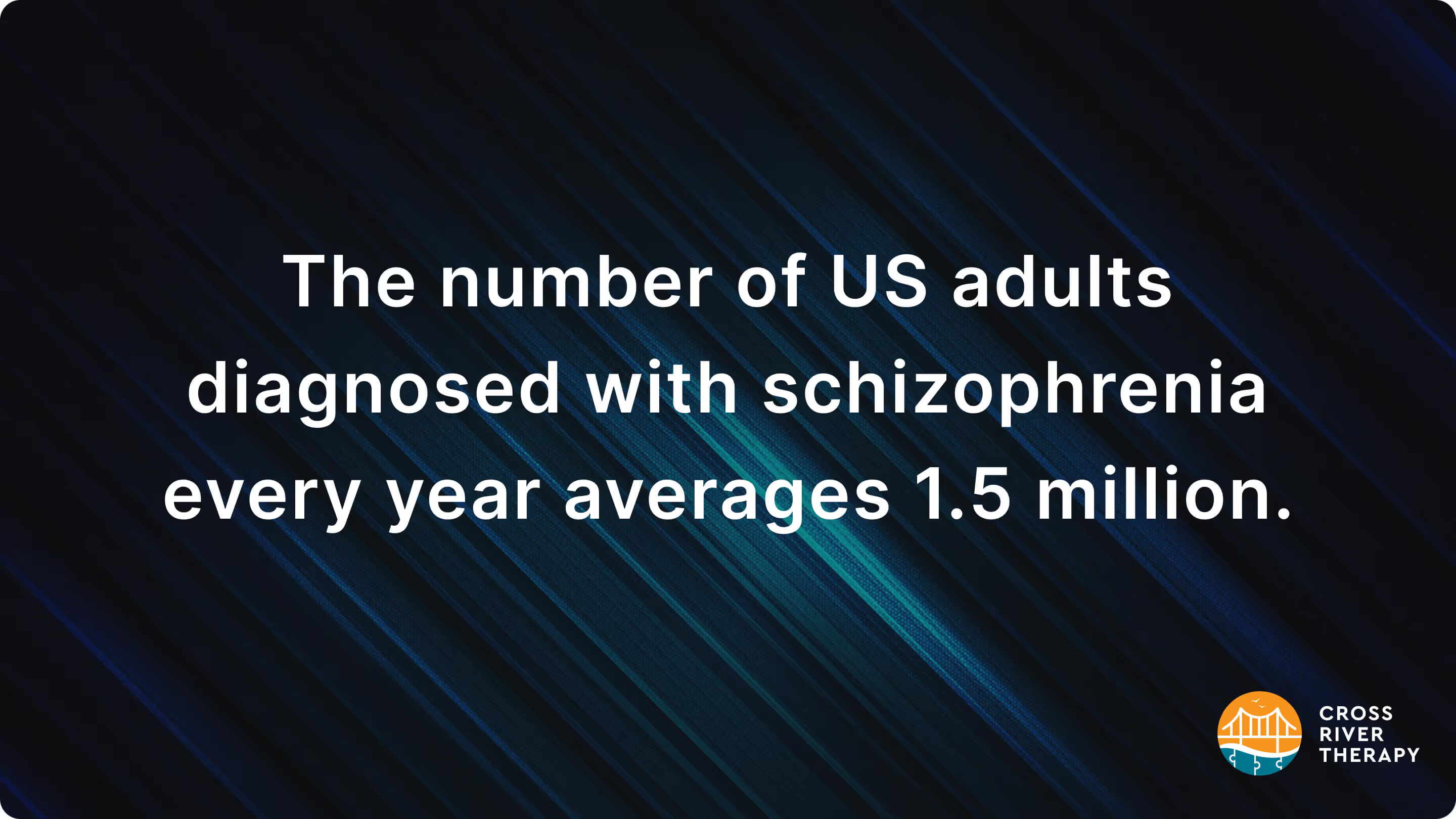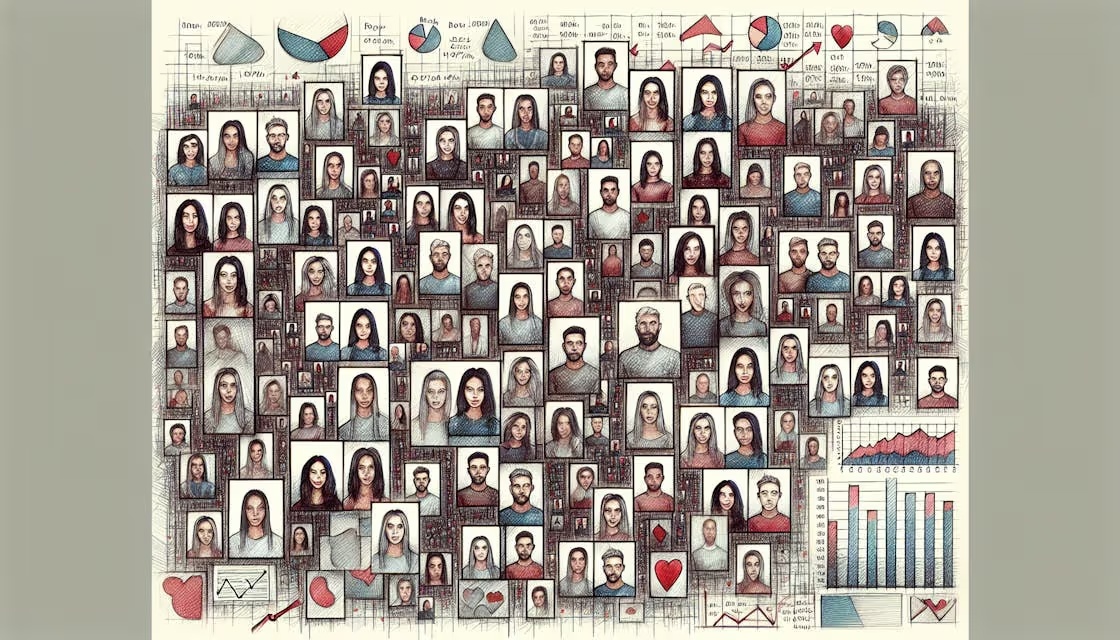39 Schizophrenia Statistics & Facts (Prevalence)
24 million people have schizophrenia but less than 33% of them receive treatment. These schizophrenia statistics illustrate the prevalence of the disorder.

Key Schizophrenia Statistics
- 24 million people have schizophrenia but less than 33% of them receive treatment.
- 90% of people diagnosed with schizophrenia have educational, personal, familial, social, and occupational issues in their day-to-day lives.
- 1.5 for every 10,000 people is the yearly amount of novel schizophrenia cases diagnosed.
- Among young adults, 1 out of every 222 individuals, or 0.45% of the global population, have schizophrenia.
- 60% of people with schizophrenia face discrimination, stigma from other individuals, and human rights abuses at some point.
- 2 out of 3 people suffering from psychosis never receive the proper healthcare they need to treat their illness, including those with schizophrenia.
- There is a multitude of options available for people with schizophrenia to get help, yet only 1 out of 3 individuals with the disorder ever recover in full.
How Many People Have Schizophrenia? Its Prevalence

- 24 million people around the world are affected with schizophrenia, according to research conducted in 2017.
- 1.5 for every 10,000 people is the yearly amount of novel schizophrenia cases diagnosed.
- Schizophrenia ranks among the top 10 causes of disability in people throughout the world.
- About 5% of individuals with schizophrenia will lose their life by committing suicide, typically when symptoms appear in the early stages of the disorder.
- 20% of individuals with schizophrenia attempt or will attempt suicide one or more times during their lifetime.
- Over 1 million Americans are diagnosed with schizophrenia every year, according to a 2019 report.
- 70% of children with schizophrenia never receive a diagnosis during their childhood.
- People with schizophrenia have a nearly 30-year loss in life expectancy than most Americans, whose average is 77 years.
Percentage Of People With Schizophrenia

- 0.32% of the worldwide population has schizophrenia. Globally, there are 24 million people with schizophrenia or 1 out of 300 individuals in every country. This amounts to 0.32% of the worldwide population.
- Among young adults, 1 out of every 222 individuals, or 0.45% of the global population, have schizophrenia.
- The onset of schizophrenia typically begins between the ages of 18 and 24 years, with symptoms showing up earlier in men than in women.
Schizophrenia Recovery Rate

- 50% of people with schizophrenia recover or improve to the extent that they can work and live independently.
- Around 20% of individuals with schizophrenia will get the treatment they need to mitigate the most severe symptoms, allowing them to carry out their daily activities in an ordinary fashion. Less than 10% of those diagnosed can make a recovery in full.
- 80% of schizophrenia sufferers stay chronically ill for their entire lives.
- 85% with schizophrenia need support from someone else to help manage their daily lives.
- 81% with schizophrenia have bouts where symptoms appear to both worsen and get better.
- Schizophrenia patients witness their symptoms increase in over 75% of cases.
- Doctors and psychologists have yet to understand the best way to mitigate risk factors for schizophrenia. The 20% of people that recover and the 80% that don't is difficult to predict.
Schizophrenia Prevalence
- By way of research using surveys based on households, medical records, and interviews regarding clinical diagnoses, the prevalence of schizophrenia in the United States ranges from 0.25% to 0.64% of the population.
- The worldwide prevalence of schizophrenia for people that aren't admitted to an institution is 0.33% to 0.75%.
- Researchers in the fields of psychiatry and mental health think that the chances of a person having schizophrenia at some time during their life are less than 1%.
- Other researchers believe the risk is higher than 1%. Nevertheless, at least 1 million people are impacted by schizophrenia in some way, and tens of millions having the disorder indirectly impact their life.
Schizophrenia Demographics
The prevalence of schizophrenia varies depending on an individual's age, gender, race, or where they live. Below are the latest statistics regarding how prevalent this disorder is by demographics.
Prevalence By Age
It's very uncommon for children under 12 years of age and adults 40 years and older to suddenly exhibit signs of schizophrenia. Although symptoms can occur at any moment, the onset average for the disorder usually begins between 18 and 32 years for women and men.
Prevalence By Gender
Schizophrenia symptoms in men typically manifest between 17 to 24 years old. Yet women show symptoms slightly later in life, usually between 27 and 33 years of age. The reasons for the gap are many, from reluctance in getting help from a psychiatrist to lacking the funds needed to pay for high medical costs.
Prevalence By Race
- With schizophrenia, the prevalence of those able to get help for symptoms on their own and receive a diagnosis is highest among African Americans, with 21.1% reporting. 19.9% of Hispanic Americans are diagnosed, and 13.1% of white Americans.
- Asian Americans have one of the lowest prevalences for schizophrenia diagnoses, with only 5.4% reporting.
- African Americans are 4 times more likely than whites to be diagnosed with schizophrenia.
Prevalence By Country
- The country with the highest prevalence of schizophrenia is Indonesia, with a total of 829,735 people with the disorder.
- The second highest prevalence is in Brazil, with 677,953 total sufferers, a significant jump from 2009 to 2019.
- Pakistan had the third highest prevalence of schizophrenia, with 505,576 citizens in the country with the disorder in 2019.
Schizophrenia Statistics In The U.S.

- The number of US adults diagnosed with schizophrenia every year averages 1.5 million.
- For young people, schizophrenia is diagnosed between 18 and 32 years old. Gender-wise, men are diagnosed earlier than women, and the average diagnosis begins in the late 20s.
- 28.5 is the average number of years lost for a sufferer of schizophrenia, putting the life expectancy for someone with the disorder at 48.78 years compared to the country's average of 77.28.
The Cost Of Schizophrenia

- In the US, the cost of schizophrenia is estimated to be $63 million a year. Compared with other mental illnesses, the cost is higher, particularly for tending to the medical and counseling needs of patients with the disorder. The amount includes expenses that employers must pay for lost work, social services, and financial benefits.
- Globally, the total direct costs related to schizophrenia are $62 billion a year. Among this, $27.2 billion goes to their health care and $14.5 billion is spent on their incarceration. The remaining is spent on housing and providing services to those that are homeless.
- Worldwide, $115 billion a year is spent on wages lost to caring for those with schizophrenia, with $104.5 billion spent on caretaking fees.
What Is Schizophrenia?
Schizophrenia is a chronic brain disorder. When it's active, symptoms can include disorganized speech, trouble with thinking, lack of motivation, delusions, and hallucinations. There is no cure for schizophrenia, but research is leading to safer and innovative treatments.
References
Recent News
Related articles
.avif)
100+ YouTube Statistics, Facts & Demographics
In 2023, YouTube has over 2.5 billion monthly active users.

39 Teacher Statistics And Demographics
Find the most up-to-date teacher demographics and statistics that'll surprise you.

Twitter Statistics for Social Media Enthusiasts [2024]
Explore compelling twitter statistics, user demographics, content engagement, and future predictions.
.avif)
89 TikTok Statistics, Facts & User Demographics
New TikTok statistics show that TikTok has quickly become one of the most popular social media platforms, with users spending an average of 52 minutes per day scrolling through videos.

Key Tinder Statistics You Need to Know
Dive into the world of Tinder statistics - revealing insights on user demographics, engagement, and global trends.
.avif)
49 Telehealth Statistics & Telemedicine Trends
Telehealth statistics show that the use of virtual care is 38 times higher than before the COVID-19 pandemic.

Teacher Salary By State: Highest-Paid Teachers By State
Today we'll breakdown a teacher's salary by state, as well as the highest-paid teachers by state.

121 Social Media Addiction Statistics Worldwide
Did you know that around 70% of teens and young adults in the US have a social media addiction?

57 Scholarship Statistics, Facts & Demographics
Did you know over 1.7 million scholarships are awarded annually? Keep reading to find more scholarship statistics.

Average Screen Time Statistics & Facts (Usage)
Did you know people spend 6 hours 58 minutes on screens everyday? Find more screen time statistics below.

59 Physical Therapy Statistics, Facts & Demographics
There are 578,565 people employed in the physical therapy industry in the US as of 2022. Find more physical therapy statistics and facts below.

Spotify Statistics: 79+ Intriguing Consumption Statistics in Music
Dive into the evolution of music with intriguing Spotify statistics; from user engagement to financial performance.

